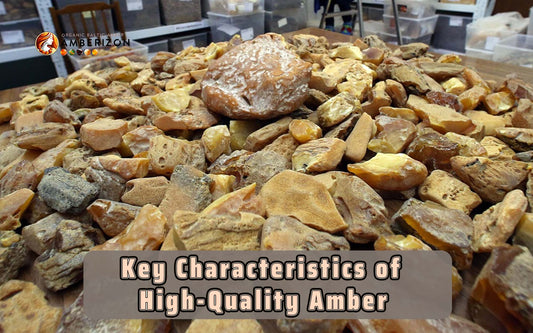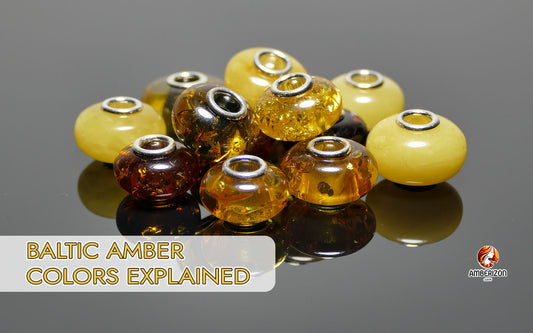
Jurassic Park and Amber: Science Meets Fiction
The Role of Amber in 'Jurassic Park'
Introduction:
The iconic Jurassic Park movie, introduced audiences to a thrilling concept that transcended fiction into reality. Central to the plot was the intriguing connection between the prehistoric world and amber, a theme that has sparked fascination and interest far beyond the silver screen.

In "Jurassic Park," amber is associated with the extraction of dinosaur DNA from prehistoric mosquitoes that are trapped in it. In the movie, scientists extract dinosaur blood from mosquitoes that had bitten them millions of years ago and then became trapped in tree sap, which eventually fossilized into amber.

The movie's premise is based on the idea that amber can preserve organisms and DNA for extended periods, although this is highly unlikely in real life due to DNA's degradation over time. The text is structured logically, with short and simple sentences in the active voice. The vocabulary is accessible and free from errors. The concept is used to explain how the dinosaurs in the park were cloned and brought back to life.

-
The connection between amber and Jurassic Park has extended beyond fiction. Amber is now a popular collectible, and replicas of the iconic mosquito-in-amber props from the films are widely available. The discovery of new and well-preserved amber specimens continues to fuel scientific interest in the possibility of extracting dinosaur DNA, keeping the tantalizing prospect of Jurassic Park-like scenarios alive in the public imagination.
What is Amber?

Amber is a fossilized resin, not a gemstone or mineral, that originates from ancient tree sap. Over millions of years, the resin hardens and preserves anything trapped inside it - like plant material, insects, or small organisms. This preservation has made amber an essential resource for scientists studying ancient ecosystems. The most famous deposits of amber are found in the Baltic region, but amber has been discovered around the world.
The Fictional Premise
In Michael Crichton's novel "Jurassic Park" and its subsequent film adaptation, amber plays a crucial role in the resurrection of dinosaurs. The story's premise is based on the idea that:
- Mosquitoes that fed on dinosaur blood became trapped in tree resin.
- This resin fossilized into amber, preserving the mosquitoes and the dinosaur blood they contained.
- Scientists extracted this preserved dinosaur DNA from the amber.
- The extracted DNA was then used to clone dinosaurs.
Amber's Role in Preservation
- Amber can indeed preserve insects and other small organisms in exceptional detail.
- Some amber specimens are over 100 million years old, dating back to the time of dinosaurs.
DNA Preservation in Amber
- While amber can preserve visual details, the preservation of DNA is more complex.
- Studies have shown that DNA degrades over time, even in ideal conditions.
- The oldest recovered DNA fragments are far younger than the age of dinosaurs.
Challenges in the Jurassic Park Scenario
- DNA Degradation: Dinosaur DNA would be too degraded after millions of years.
- Incomplete Genomes: Even if some DNA survived, it wouldn't be a complete genome.
- Blood Meal Size: The amount of dinosaur blood in a mosquito would be minimal.
- Species Identification: Determining which dinosaur the blood came from would be challenging.
Impact on Public Interest in Amber
The Jurassic Park franchise has had a significant impact on public interest in amber:
- Increased Popularity: Amber gained widespread attention and fascination.
- Educational Opportunities: It sparked interest in paleontology and fossilization processes.
- Market Impact: The popularity of amber jewelry and collectibles increased.
- Scientific Research: There was renewed interest in studying insects and other inclusions in amber.
Scientific Advancements Inspired by the Concept
While we can't recreate dinosaurs as depicted in Jurassic Park, the concept has inspired related scientific pursuits:
- Ancient DNA Studies: Improved techniques for studying DNA from ancient specimens.
- De-extinction Debates: Discussions about the ethics and feasibility of resurrecting extinct species.
- Amber Research: Increased funding and interest in amber studies.
Amber as a Symbol in Jurassic Park
Beyond its fictional role as the key to resurrecting dinosaurs, amber serves as a symbolic object in Jurassic Park. It represents a bridge between the ancient past and the modern world. In the film, amber is depicted as a beautiful yet dangerous substance—it holds the allure of scientific discovery but also the potential for catastrophic consequences, as we see when the resurrected dinosaurs wreak havoc.
Amber’s Impact Beyond the Movie
The release of Jurassic Park not only thrilled audiences but also sparked a newfound interest in amber. Fossil enthusiasts, collectors, and even fashion designers began to see amber in a new light. Suddenly, this ancient resin was more than just a beautiful gemstone - it became a symbol of prehistoric wonder.
After the film, interest in amber jewelry and fossils surged, and amber became a topic of fascination not only for its aesthetic appeal but also for its scientific significance. In many ways, Jurassic Park made amber cool again, connecting the world of paleontology with mainstream culture.






